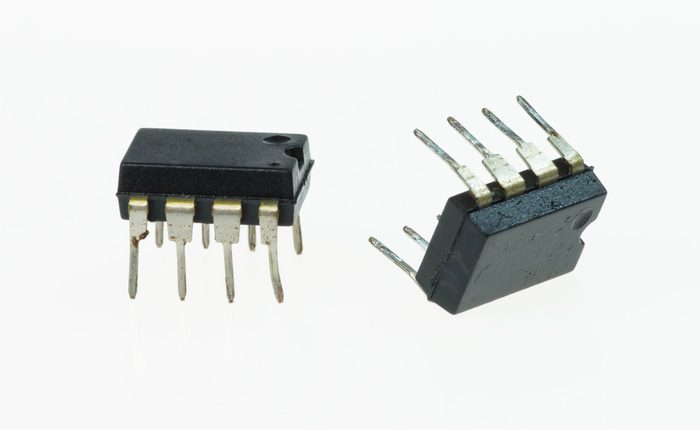
You’ll find this type of operational amplifier circuit in an NE5532 datasheet.
Most engineers are familiar with the LM358 and LM741 op-amps, but the NE5532 op-amp may be a better choice in some higher frequency applications where lower noise is required. Whether you’re designing for pro audio, pro video, sensor interfacing, or vibration measurement, this component is one option that provides greater noise suppression and higher bandwidth than other standard op-amps.
Like many components not branded by specific manufacturers, there are multiple variants of the NE5532. Some of these are manufacturer-specific with an attached alphanumeric string, but these are based on standardized variant components. Therefore, some specs in an NE5532 datasheet may differ across manufacturers. However, there are some standard specifications that all NE5532 components share, regardless of manufacturer.
When you need to source an NE5532 op-amp for your new system and find technical specs, you need to use a service that provides an NE5532 datasheet for a range of different variants. You’ll also prevent redesigns when you can get sourcing information for an NE5532 alongside datasheets, CAD models, and lifecycle information. Here’s what to watch for in an NE5532 datasheet and how these components stack up to other op-amp ICs.
What’s in the NE5532 Datasheet
Like many other components that are produced by multiple manufacturers, NE5532 is not a specific product brand. Different manufacturers produce their own variants (both through-hole and surface-mount components). Any NE5532 datasheet will include the following information:
- PCB footprint dimensions. These components are available in PDIP/CDIP, SO, or SOIC packages. The dimensions of these packages are shown in the NE5532 datasheets, allowing you to create your own footprints if desired. The SOIC package uses a gullwing lead, which makes designing a 3D model for the component difficult.
- Electrical specifications. The list of technical specifications in an NE5532 datasheet is too long to list here. In general, the NE5532 runs up to 22 V supply voltage with high DC gain.
- Circuit and application diagrams. You’ll typically find the actual circuit diagram for one of the op-amp stages in an NE5532 datasheet. In addition, a typical application diagram will give you a good place to start creating a larger system around your designs.
The two primary variants of the NE5532 are the SE5532 and SA5532; these variants then have their own manufacturer-specific variants, just like many other ICs (e.g., 7400 series ICs). If you try searching for an SE5532 or SA5532 datasheet, you’ll end up coming to an NE5532 datasheet. This is because the only differences between these components are the rated temperature ranges; these ranges for different variants are shown below.
| Variant | Temperature Range (°C) | |
| NE5532 | 0 to 70 | |
| SA5532 | -40 to 85 | |
| SE5532 | -55 to 125 | |
Aside from these differences, these three components are largely the same and will use the same suffixes to denote different packages and features. If you’re considering a different op-amp, such a 7400 series or LM358, it helps to compare the critical specifications as these different op-amp ICs are similar.
NE5532 vs. LM358
The NE5532 and LM358 are similar in that they are both dual-channel op-amps in a combined package. They also have similar footprints, depending on the manufacturer. Texas Instruments is well-known for making both components, but other manufacturers like ON Semiconductor and NXP produce their own NE5532 models. All these components offer the same core functions and are marketed as “low-noise” operational amplifiers. These two components even have the same pinout in PDIP/CPID packages.
So where are the differences between these components? Rather than let you comb through an LM358 and NE5532 datasheet, the table below shows some key specifications where these two components differ.
| NE5532 | LM358 | |
| Supply voltage | Up to +/- 22 V | Up to +/- 30 V |
| Gain-bandwidth product | 10 MHz | 1-1.2 MHz |
| Common-mode rejection ratio (CMRR) | Up to ~100 dB | Up to ~85 dB |
| DC gain | Up to 100,000 | Up to 200,000 |
| Output short-circuit current | Up to 60 mA | Up to 60 mA |
Note the gain-bandwidth product and CMRR values for the NE5532 are much larger than for the LM358. The rolloff in the frequency response spectrum is flat out to 100 kHz, which accommodates the entire range of human hearing and accommodates ultrasonic frequencies. The difference in gain between these components is only a factor 2, so the NE5532 is still perfectly capable of accepting and amplifying low-level signals. This makes the NE5532 a better option for applications like pro audio, video transcoding, vibration measurement, and other areas where high gain and low noise are required. Pre-amplification before A/D conversion is one useful application of an NE5532.
Find Your Amplifier and Datasheets with a Parts Search Engine
Once you’ve selected the NE5532 variant you need for your specific application, you still need to source your components and find an NE5532 datasheet. When you use the right component search engine, you can quickly find datasheets for NE5532 variants and compare different variants. In addition to datasheets and electrical specifications, a components search engine can give you some important tools to start your design:
- CAD and simulation models. You’ll need schematic symbols, a PCB footprint, and 3D CAD models for your components. SPICE simulation models and subcircuits are also useful, especially for common components like an NE5532 op-amp.
- Sourcing data. Access to prices, available stock, lead times, MOQs, and a distributor list help ensure your new product can be manufactured in the quantity you need.
- Lifecycle status. Ensuring your new product is manufacturable requires identifying in-production, NRND, and obsolete components. Identifying and replacing obsolete and NRND components increases the lifetime of your new product.
Whether you need to find an NE5532 datasheet or find specifications on other specialized amplifiers, try using the parts search features in Ultra Librarian. You can easily search a range of parts and find verified CAD models in vendor-specific and vendor-neutral file formats at no cost. Once you find your component footprints, they can easily be imported into popular ECAD applications. You’ll also be able to see up-to-date sourcing information from authorized worldwide distributors for all your components.
Ultra Librarian helps you build your component footprint libraries by compiling all your sourcing and component information in one place. Working with Ultra Librarian sets up your team for success to ensure any design is going through production and validation with accurate models and footprints to work from. Register today for free!








